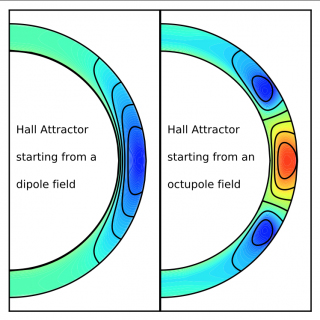 New findings could help advance understanding of matter at extreme densities
New findings could help advance understanding of matter at extreme densities
By Chris Chipello
Neutron stars, the extraordinarily dense stellar bodies created when massive stars collapse, are known to host the strongest magnetic fields in the universe – as much as a billion times more powerful than any man-made electromagnet. But some neutron stars are much more strongly magnetized than others, and this disparity has long puzzled astrophysicists.
Now, a study by McGill physicists Konstantinos Gourgouliatos and Andrew Cumming sheds new light on the expected geometry of the magnetic field in neutron stars. The findings, published online April 29 in Physical Review Letters, could help scientists measure the mass and radius of these unusual stellar bodies, and thereby gain insights into the physics of matter at extreme densities.
Some previous theoretical studies have suggested that the magnetic field of a neutron star should break into smaller loops and dissipate as the star ages – a phenomenon known as “turbulent cascade.” Yet, there are several “middle-aged” neutron stars (roughly one million to a few million years old) that are known to have relatively strong magnetic fields, leaving scientists at a loss to reconcile the theoretical models with actual observations.
To better understand how the magnetic field changes as a neutron star ages, Gourgouliatos and Cumming ran a series of computer simulations. These showed the magnetic field evolving rapidly at first, in line with previous predictions. But then the evolution took a surprising turn: in all the simulations, no matter what the magnetic field looked like when the neutron star was born, the field took on a particular structure and its evolution dramatically slowed.
“A cascade in a magnetic field is akin to what happens when you add cream to your coffee and stir it: the cream rapidly gets broken up into pieces and mixes into the coffee,” Cumming explains. “The original prediction was that neutron star crusts would do the same to their magnetic fields; so if you could walk around on the surface with a compass trying to walk towards magnetic north, you would end up walking around in random directions. Instead, we find in these new simulations that the magnetic field actually remains quite simple in structure – as if the cream refused to mix into the coffee – and you could, indeed, use a compass to navigate around on the surface of the star.”
The McGill researchers call this final magnetic-field configuration the “Hall attractor” state, after the so-called Hall effect, which is thought by astrophysicists to drive magnetic field evolution in neutron-star crusts. “This result is also significant because it shows that the Hall effect, a phenomenon first discovered in terrestrial materials and which is thought to help weaken a magnetic field through turbulence, can actually lead to an attractor state with a stable magnetic-field structure,” Gourgouliatos says.
Read the original article here.
